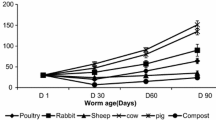Abstract
Epigeic earthworms (Oligochaeta) have been appeared as key organisms to convert organic waste resources into value-added products, i.e., vermicompost and worm biomass. The assessment of reproduction potential of composting earthworm may be beneficial for large-scale earthworm production. Although, the waste minimizing potential of Perionyx excavatus and Perionyx sansibaricus is well proved, but little information is available about their fecundity rate. In this study, the efforts have been made to explore the growth and reproduction biology of P. excavatus and P. sansibaricus, using cattle waste solid as culture substrate, under laboratory conditions. Earthworms were weighed weekly and number of cocoons produced per week assessed. Biomass productions, fecundity, maturation, natality all were significantly different between P. excavatus and P. sansibaricus. The highest mean individual biomass was 767.7 ± 18.4 mg and 612.6 ± 20.6 mg, respectively in P. sansibaricus and P. excavatus. However, the highest cocoon numbers occurred in P. excavatus (492.3 ± 13.6), significantly higher than P. sansibaricus (269.6 ± 17.1). Fecundity was slightly different in both species: 1.38 ± 0.77 cocoons adult worm−1 week−1 (P. excavatus) and 1.58 ± 0.74 cocoons adult worm−1 week−1 (P. sansibaricus). The hatchling success rate (%) was highest in P. excavatus. Overall natality (juveniles adult−1 week−1) was highest in P. sansibaricus (1.52) than P. excavatus (1.26), which suggests that P. sansibaricus may be a better candidate for rapid propagation of earthworms in cattle waste solid.


Similar content being viewed by others
References
Anderson JM, Ingram JSI (1993) Soil organic matter and organic carbon. In: Anderson JM, Ingram JSI (eds) Tropical soil biology and fertility. CAB Internationals, Wallingford
Delgado M, Bigeriego M, Walter I, Calbo R (1995) Use of California red worm in sewage sludge transformation. Turrialba 45:33–41
Dominguez J, Edwards CA, Ashby J (2001) The biology and population dynamics of Eudrilus eugeniae (Kinberg) (Oligochaeta) in cattle waste solids. Pedobiologia (Jena) 45:341–353. doi:10.1078/0031-4056-00091
Edwards CA, Dominguez J, Neuhauser EF (1998) Growth and reproduction of Perionyx excavatus (Perr.) (Megascolecidae) as factors in organic waste management. Biol Fertil Soils 27:155–161. doi:10.1007/s003740050414
Garcia JM, Fragoso C (2003) Influence of different food substrates on growth and reproduction of two tropical earthworm species (Pontoscolex corethrurus and Amynthas corticis). Pedobiologia (Jena) 47:754–763
Garg VK, Kaushik P (2005) Vermistabilization of textile mill sludge spiked with poultry droppings by an epigeic earthworm Eisenia fetida. Bioresour Technol 96:1063–1071. doi:10.1016/j.biortech.2004.09.003
Garg VK, Yadav YK, Sheoran A, Chand S, Kausik P (2006) Livestock excreta management through vermicomposting using epigeic earthworm Eisenia fetida. Environmentalist 26:269–276. doi:10.1007/s10669-006-8641-z
Gates GE (1972) Burmese earthworms: an introduction to the systematic and biology of Megadriliae Oligochaeta with special reference to Southeast Asia. Trans Am Philos Soc 62:1–326. doi:10.2307/1006214
Hallatt L, Reinecke AJ, Viljoen SA (1990) The life cycle of the oriental compost worm Perionyx excavatus (Oligochaeta). S Afr J Zool 25:41–45
Hartenstein R, Neuhauser EF, Kaplan DL (1979) Reproduction potential of earthworm Eisenia foetida. Oecologia 43:329–340. doi:10.1007/BF00344959
Jackson ML (1975) Soil chemical analysis. Pranctice Hall of India, New Delhi
Kale RD, Bano K, Krishnamoorthy RV (1982) Potential of Perionyx excavatus for utilizing organic wastes. Pedobiologia (Jena) 23:419–425
Lee KE (1992) Some trends opportunities in earthworm research or: Darwin’s children. The future of our discipline. Soil Biol Biochem 24:1765–1771. doi:10.1016/0038-0717(92)90185-Z
Loehr RC, Martin JH, Neuhauser EF, Malecki MR (1984) Final project report submitted to the national Science Foundation, Department of Agriculture Engineering, Cornell University, New York, 118 pp
Ndegwa PM, Thompson SA, Das KC (2000) Effects of stocking density and feeding rate on vermicomposting of biosolids. Bioresour Technol 71:5–12. doi:10.1016/S0960-8524(99)00055-3
Reinecke AJ, Viljoen SA, Saayman RJ (1992) The suitability of Eudrilus eugeniae, Perionyx excavatus and Eisenia fetida (Oligochaeta) for vermicomposting in southern Africa in terms of their temperature requirements. Soil Biol Biochem 24(12):1295–1307. doi:10.1016/0038-0717(92)90109-B
Simard RR (1993) Ammonium acetate extractable elements. In: Martin R, Caster S (eds) Soil sampling and methods of analysis. Lewis Publisher, Florida, pp 39–43
Stephenson J (1930) The oligochaeta. Oxford University Press, Oxford
Suthar S (2006) Potential utilization of guargum industrial waste in vermicompost production. Bioresour Technol 97:2474–2477
Suthar S (2007a) Nutrient changes and biodynamics of epigeic earthworm Perionyx excavatus (Perrier) during recycling of some agricultural wastes. Bioresour Technol 98:1608–1614. doi:10.1016/j.biortech.2006.06.001
Suthar S (2007b) Vermicomposting potential of Perionyx sansibaricus (Perrier) in different waste materials. Bioresour Technol 98:1231–1237. doi:10.1016/j.biortech.2006.05.008
Suthar S (2007c) Production of vermifertilizer from guar gum industrial waste by using composting earthworm Perionyx sansibaricus (Perrier). Environmentalist 27(1):329–335. doi:10.1007/s10669-007-9032-9
Suthar S (2008a) Bioconversion of post harvest crop residues and cattle shed manure into value-added products using earthworms Eudrilus eugeniae Kinberg. Ecol Eng 32:206–214. doi:10.1016/j.ecoleng.2007.11.002
Suthar S (2008b) Development of a novel epigeic-anecic-based polyculture vermireactor for efficient treatment of municipal sewage water sludge. Int J Environ Waste Manage 2(1/2):84–101. doi:10.1504/IJEWM.2008.016994
Suthar S, Ram S (2008) Does substrate quality affects the earthworm growth and reproduction patterns in vermicomposting system? A study using three popular epigeic earthworm species. Int J Environ Waste Manage (in press)
Suthar S, Singh S (2008a) Vermicomposting of domestic waste by using two epigeic earthworms (Perionyx excavatus and Perionyx sansibaricus). Int J Environ Sci Technol 5(1):99–106
Suthar S, Singh S (2008b) Feasibility of vermicomposting in biostabilization sludge from a distillery industry. Sci Total Environ 393:237–243. doi:10.1016/j.scitotenv.2008.02.005
Walkley A, Black IA (1934) An examination of the degtjareff method for determining soil organic matter and prepared modification of the chronic acid titration method. Soil Sci 34:29–38
Acknowledgment
Author is grateful to two anonymous reviewers for valuable comments and careful revision of the earlier version of manuscript.
Author information
Authors and Affiliations
Corresponding author
Rights and permissions
About this article
Cite this article
Suthar, S. Growth and fecundity of earthworms: Perionyx excavatus and Perionyx sansibaricus in cattle waste solids. Environmentalist 29, 78–84 (2009). https://doi.org/10.1007/s10669-008-9185-1
Received:
Accepted:
Published:
Issue Date:
DOI: https://doi.org/10.1007/s10669-008-9185-1




